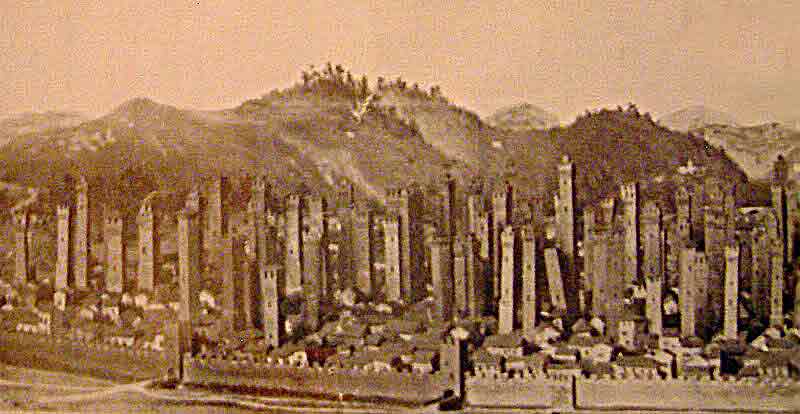 Sure, we all think we "must go" to Pisa and see the leaning tower, but thousands of others have the same idea. Pisa is very crowded, especially in the Piazza dei Miracoli where the the Leaning Tower is located. Many don't even find the time (or money) to climb the tower itself. If driving, Pisa is also clogged with traffic and expensive to park close to the Tower. Aside from the Piazza dei Miracoli which encompasses to Tower, Basilica and the Baptistry, most visitors spend only an hour or two at the Piazza and then leave the city, not seeing anything else of Pisa (even though it is a beautiful city, especially along the river). So... Instead of visiting the Leaning Tower of Pisa, visit the Leaning Towers of Bologna instead... The Leaning Towers of Bologna (yes, there's two) are in the middle of a wonderful city with a well-preserved historical center (one of the largest in Italy) thanks to a careful restoration and conservation policy which began at the end of the 1970s. Bologna is the largest city (and the capital) of the Emilia-Romagna Region. The highlight of Bologna is it's twin leaning towers, but trust me, Bologna is a city where you can stay for a while... there much more than the Towers to see here. But first, a little info about its leaning towers... The taller of the leaning towers in Bologna is called the Asinelli while the smaller but more leaning tower is called the Garisenda. Asinelli Tower measures 318 feet tall and the Garisenda Tower stands at 158 feet. For 3 Euros you can climb to the top of the Asinelli Tower but be advised, this climb is not for those who are afraid of height (the old wooden stairs are open in the middle looking all the way to the top and bottom) or are out of shape. There are almost 500 steps to the top. Also be aware that the stairway is very narrow with worn, uneven steps... and you have to squeeze past people on the way up and the way down. It will take about 10 minutes to reach the top (resting every few levels) but the views are amazing.  The famous porticoes in Bologna go on for miles... The famous porticoes in Bologna go on for miles... Bologna has been settled from 1000 BC onwards. The Celts, the Romans, the Gauls, the Lombards and even Byzantium all had a part in its history. In the 12th century, the expanding city needed a new line of walls, and at the end of the 13th century had one of largest textile industries in Italy. The complex system of canals in Bologna was one of the most advanced waterway systems in Europe. Hydraulic energy derived from the canal system ran the numerous textile mills and helped transport goods. Bologna is also a university town... in fact, founded in 1088, the University of Bologna is widely considered to be the world's first university. Feminists owe a great deal to Bologna as well. During the Renaissance, Bologna was the only Italian city that allowed women to excel in any profession. Women had much more freedom than in other Italian cities; some even had the opportunity to earn a degree at the university. The School of Bologna for art flourished in Bologna between the 16th and 17th centuries, and rivaled Florence and Rome as a center of painting. But remember, this is a modern, living, breathing city. It's as beautiful as Lucca but larger. The reddish brown color of the buildings and covered porticoes invite you to walk and explore--in total, there are 24 miles of porticoes in the city's historical center allowing visitors to stroll throughout the historic center protected from inclement weather. In addition to its two famous leaning towers, there are about 18 more still remaining that stand relatively straight. There is an antiques market at Piazza Santo Stefano. Imagine that at one time there were about 180 towers in the 1200s. Most either fell down, were torn down or shortened and re-purposed. Sadly, during a new urban development plan at the beginning of the 20th century, the last remaining towers were torn down. The modern attitude is to preserve the towers that remain. Lucky for the people who live and visit Bologna! Now, as to what else Bologna has to offer... The International museum and library of music displays ancient musical instruments and unique musical scores from the 16th to the 20th centuries. The Basilica of San Domenico is worth seeing, with its Romanesque facade and Baroque interior decorations and frescoes. And for a vista overlooking the city, take a trip up to San Michele in Bosco perched on a forested hilltop overlooking Bologna. You can also visit a Parmigiano Reggiano factory or a Ducati motorcycle factory--take your pick. As for food, there is always the sauce Bolognese to feed the hungry traveler. So perhaps you would still want to visit Pisa to see its Leaning Tower, but after a short two hour visit, jump on a train for a couple of hours and visit Bologna for a few days. One great itinerary would be to fly into Pisa, see their tower, then get on a train to spend a couple of days at Lucca to relax and perhaps rent a bicycle and ride on top of their walls, then move on to Vinci to get a taste of Leonardo's genius in the Da Vinci Museum (an over-nighter), then move on for a few day stay in Bologna for a taste of a vibrant, wonderful Italian city. You could finish off your trip in Venice and fly home from there. Have some tagliatelle alla Bolognese for me! --Jerry Finzi Copyright, Jerry Finzi, Grand Voyage Italy, All rights reserved
0 Comments
Your comment will be posted after it is approved.
Leave a Reply. |
Categories
All
Archive
June 2024
|









 RSS Feed
RSS Feed
